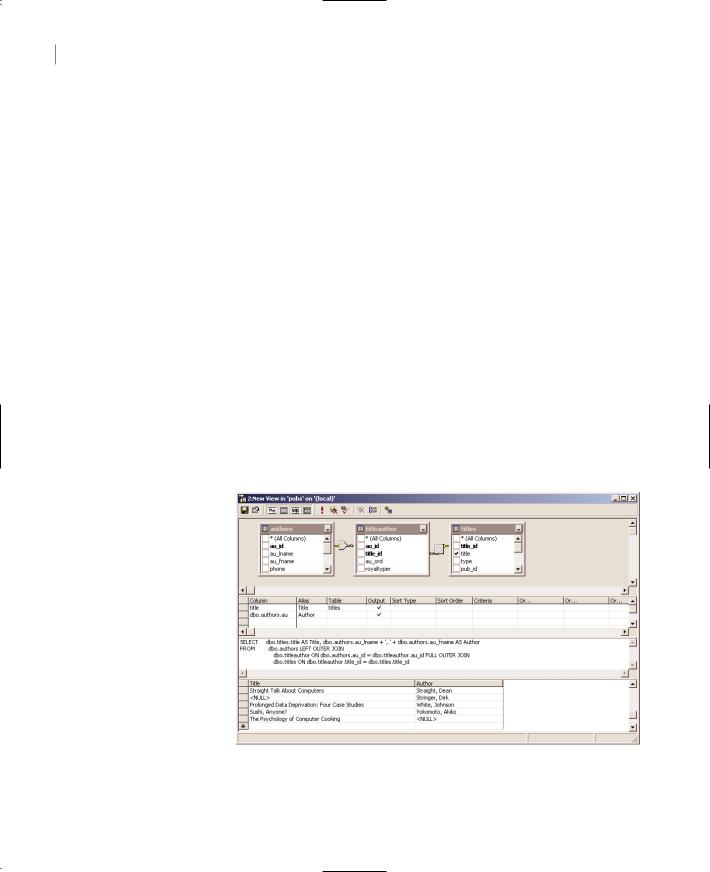
- •Using Your Sybex Electronic Book
- •Acknowledgments
- •Contents at a Glance
- •Introduction
- •Who Should Read This Book?
- •How About the Advanced Topics?
- •The Structure of the Book
- •How to Reach the Author
- •The Integrated Development Environment
- •The Start Page
- •Project Types
- •Your First VB Application
- •Making the Application More Robust
- •Making the Application More User-Friendly
- •The IDE Components
- •The IDE Menu
- •The Toolbox Window
- •The Solution Explorer
- •The Properties Window
- •The Output Window
- •The Command Window
- •The Task List Window
- •Environment Options
- •A Few Common Properties
- •A Few Common Events
- •A Few Common Methods
- •Building a Console Application
- •Summary
- •Building a Loan Calculator
- •How the Loan Application Works
- •Designing the User Interface
- •Programming the Loan Application
- •Validating the Data
- •Building a Math Calculator
- •Designing the User Interface
- •Programming the MathCalculator App
- •Adding More Features
- •Exception Handling
- •Taking the LoanCalculator to the Web
- •Working with Multiple Forms
- •Working with Multiple Projects
- •Executable Files
- •Distributing an Application
- •VB.NET at Work: Creating a Windows Installer
- •Finishing the Windows Installer
- •Running the Windows Installer
- •Verifying the Installation
- •Summary
- •Variables
- •Declaring Variables
- •Types of Variables
- •Converting Variable Types
- •User-Defined Data Types
- •Examining Variable Types
- •Why Declare Variables?
- •A Variable’s Scope
- •The Lifetime of a Variable
- •Constants
- •Arrays
- •Declaring Arrays
- •Initializing Arrays
- •Array Limits
- •Multidimensional Arrays
- •Dynamic Arrays
- •Arrays of Arrays
- •Variables as Objects
- •So, What’s an Object?
- •Formatting Numbers
- •Formatting Dates
- •Flow-Control Statements
- •Test Structures
- •Loop Structures
- •Nested Control Structures
- •The Exit Statement
- •Summary
- •Modular Coding
- •Subroutines
- •Functions
- •Arguments
- •Argument-Passing Mechanisms
- •Event-Handler Arguments
- •Passing an Unknown Number of Arguments
- •Named Arguments
- •More Types of Function Return Values
- •Overloading Functions
- •Summary
- •The Appearance of Forms
- •Properties of the Form Control
- •Placing Controls on Forms
- •Setting the TabOrder
- •VB.NET at Work: The Contacts Project
- •Anchoring and Docking
- •Loading and Showing Forms
- •The Startup Form
- •Controlling One Form from within Another
- •Forms vs. Dialog Boxes
- •VB.NET at Work: The MultipleForms Project
- •Designing Menus
- •The Menu Editor
- •Manipulating Menus at Runtime
- •Building Dynamic Forms at Runtime
- •The Form.Controls Collection
- •VB.NET at Work: The DynamicForm Project
- •Creating Event Handlers at Runtime
- •Summary
- •The TextBox Control
- •Basic Properties
- •Text-Manipulation Properties
- •Text-Selection Properties
- •Text-Selection Methods
- •Undoing Edits
- •VB.NET at Work: The TextPad Project
- •Capturing Keystrokes
- •The ListBox, CheckedListBox, and ComboBox Controls
- •Basic Properties
- •The Items Collection
- •VB.NET at Work: The ListDemo Project
- •Searching
- •The ComboBox Control
- •The ScrollBar and TrackBar Controls
- •The ScrollBar Control
- •The TrackBar Control
- •Summary
- •The Common Dialog Controls
- •Using the Common Dialog Controls
- •The Color Dialog Box
- •The Font Dialog Box
- •The Open and Save As Dialog Boxes
- •The Print Dialog Box
- •The RichTextBox Control
- •The RTF Language
- •Methods
- •Advanced Editing Features
- •Cutting and Pasting
- •Searching in a RichTextBox Control
- •Formatting URLs
- •VB.NET at Work: The RTFPad Project
- •Summary
- •What Is a Class?
- •Building the Minimal Class
- •Adding Code to the Minimal Class
- •Property Procedures
- •Customizing Default Members
- •Custom Enumerations
- •Using the SimpleClass in Other Projects
- •Firing Events
- •Shared Properties
- •Parsing a Filename String
- •Reusing the StringTools Class
- •Encapsulation and Abstraction
- •Inheritance
- •Inheriting Existing Classes
- •Polymorphism
- •The Shape Class
- •Object Constructors and Destructors
- •Instance and Shared Methods
- •Who Can Inherit What?
- •Parent Class Keywords
- •Derived Class Keyword
- •Parent Class Member Keywords
- •Derived Class Member Keyword
- •MyBase and MyClass
- •Summary
- •On Designing Windows Controls
- •Enhancing Existing Controls
- •Building the FocusedTextBox Control
- •Building Compound Controls
- •VB.NET at Work: The ColorEdit Control
- •VB.NET at Work: The Label3D Control
- •Raising Events
- •Using the Custom Control in Other Projects
- •VB.NET at Work: The Alarm Control
- •Designing Irregularly Shaped Controls
- •Designing Owner-Drawn Menus
- •Designing Owner-Drawn ListBox Controls
- •Using ActiveX Controls
- •Summary
- •Programming Word
- •Objects That Represent Text
- •The Documents Collection and the Document Object
- •Spell-Checking Documents
- •Programming Excel
- •The Worksheets Collection and the Worksheet Object
- •The Range Object
- •Using Excel as a Math Parser
- •Programming Outlook
- •Retrieving Information
- •Recursive Scanning of the Contacts Folder
- •Summary
- •Advanced Array Topics
- •Sorting Arrays
- •Searching Arrays
- •Other Array Operations
- •Array Limitations
- •The ArrayList Collection
- •Creating an ArrayList
- •Adding and Removing Items
- •The HashTable Collection
- •VB.NET at Work: The WordFrequencies Project
- •The SortedList Class
- •The IEnumerator and IComparer Interfaces
- •Enumerating Collections
- •Custom Sorting
- •Custom Sorting of a SortedList
- •The Serialization Class
- •Serializing Individual Objects
- •Serializing a Collection
- •Deserializing Objects
- •Summary
- •Handling Strings and Characters
- •The Char Class
- •The String Class
- •The StringBuilder Class
- •VB.NET at Work: The StringReversal Project
- •VB.NET at Work: The CountWords Project
- •Handling Dates
- •The DateTime Class
- •The TimeSpan Class
- •VB.NET at Work: Timing Operations
- •Summary
- •Accessing Folders and Files
- •The Directory Class
- •The File Class
- •The DirectoryInfo Class
- •The FileInfo Class
- •The Path Class
- •VB.NET at Work: The CustomExplorer Project
- •Accessing Files
- •The FileStream Object
- •The StreamWriter Object
- •The StreamReader Object
- •Sending Data to a File
- •The BinaryWriter Object
- •The BinaryReader Object
- •VB.NET at Work: The RecordSave Project
- •The FileSystemWatcher Component
- •Properties
- •Events
- •VB.NET at Work: The FileSystemWatcher Project
- •Summary
- •Displaying Images
- •The Image Object
- •Exchanging Images through the Clipboard
- •Drawing with GDI+
- •The Basic Drawing Objects
- •Drawing Shapes
- •Drawing Methods
- •Gradients
- •Coordinate Transformations
- •Specifying Transformations
- •VB.NET at Work: Plotting Functions
- •Bitmaps
- •Specifying Colors
- •Defining Colors
- •Processing Bitmaps
- •Summary
- •The Printing Objects
- •PrintDocument
- •PrintDialog
- •PageSetupDialog
- •PrintPreviewDialog
- •PrintPreviewControl
- •Printer and Page Properties
- •Page Geometry
- •Printing Examples
- •Printing Tabular Data
- •Printing Plain Text
- •Printing Bitmaps
- •Using the PrintPreviewControl
- •Summary
- •Examining the Advanced Controls
- •How Tree Structures Work
- •The ImageList Control
- •The TreeView Control
- •Adding New Items at Design Time
- •Adding New Items at Runtime
- •Assigning Images to Nodes
- •Scanning the TreeView Control
- •The ListView Control
- •The Columns Collection
- •The ListItem Object
- •The Items Collection
- •The SubItems Collection
- •Summary
- •Types of Errors
- •Design-Time Errors
- •Runtime Errors
- •Logic Errors
- •Exceptions and Structured Exception Handling
- •Studying an Exception
- •Getting a Handle on this Exception
- •Finally (!)
- •Customizing Exception Handling
- •Throwing Your Own Exceptions
- •Debugging
- •Breakpoints
- •Stepping Through
- •The Local and Watch Windows
- •Summary
- •Basic Concepts
- •Recursion in Real Life
- •A Simple Example
- •Recursion by Mistake
- •Scanning Folders Recursively
- •Describing a Recursive Procedure
- •Translating the Description to Code
- •The Stack Mechanism
- •Stack Defined
- •Recursive Programming and the Stack
- •Passing Arguments through the Stack
- •Special Issues in Recursive Programming
- •Knowing When to Use Recursive Programming
- •Summary
- •MDI Applications: The Basics
- •Building an MDI Application
- •Built-In Capabilities of MDI Applications
- •Accessing Child Forms
- •Ending an MDI Application
- •A Scrollable PictureBox
- •Summary
- •What Is a Database?
- •Relational Databases
- •Exploring the Northwind Database
- •Exploring the Pubs Database
- •Understanding Relations
- •The Server Explorer
- •Working with Tables
- •Relationships, Indices, and Constraints
- •Structured Query Language
- •Executing SQL Statements
- •Selection Queries
- •Calculated Fields
- •SQL Joins
- •Action Queries
- •The Query Builder
- •The Query Builder Interface
- •SQL at Work: Calculating Sums
- •SQL at Work: Counting Rows
- •Limiting the Selection
- •Parameterized Queries
- •Calculated Columns
- •Specifying Left, Right, and Inner Joins
- •Stored Procedures
- •Summary
- •How About XML?
- •Creating a DataSet
- •The DataGrid Control
- •Data Binding
- •VB.NET at Work: The ViewEditCustomers Project
- •Binding Complex Controls
- •Programming the DataAdapter Object
- •The Command Objects
- •The Command and DataReader Objects
- •VB.NET at Work: The DataReader Project
- •VB.NET at Work: The StoredProcedure Project
- •Summary
- •The Structure of a DataSet
- •Navigating the Tables of a DataSet
- •Updating DataSets
- •The DataForm Wizard
- •Handling Identity Fields
- •Transactions
- •Performing Update Operations
- •Updating Tables Manually
- •Building and Using Custom DataSets
- •Summary
- •An HTML Primer
- •HTML Code Elements
- •Server-Client Interaction
- •The Structure of HTML Documents
- •URLs and Hyperlinks
- •The Basic HTML Tags
- •Inserting Graphics
- •Tables
- •Forms and Controls
- •Processing Requests on the Server
- •Building a Web Application
- •Interacting with a Web Application
- •Maintaining State
- •The Web Controls
- •The ASP.NET Objects
- •The Page Object
- •The Response Object
- •The Request Object
- •The Server Object
- •Using Cookies
- •Handling Multiple Forms in Web Applications
- •Summary
- •The Data-Bound Web Controls
- •Simple Data Binding
- •Binding to DataSets
- •Is It a Grid, or a Table?
- •Getting Orders on the Web
- •The Forms of the ProductSearch Application
- •Paging Large DataSets
- •Customizing the Appearance of the DataGrid Control
- •Programming the Select Button
- •Summary
- •How to Serve the Web
- •Building a Web Service
- •Consuming the Web Service
- •Maintaining State in Web Services
- •A Data-Driven Web Service
- •Consuming the Products Web Service in VB
- •Summary

914 Chapter 20 DATABASES: ARCHITECTURE AND BASIC CONCEPTS
The wizard will replace the field names with fully qualified names:
(dbo.[Order Details].Quantity * dbo.Products.UnitPrice) * (1 - dbo.[Order Details].Discount)
This expression calculates the subtotal for each line in the Order Details table. We multiply the price with the quantity, taking into consideration the discount. Shortly, we’re going to sum the subtotals for each product.
Because this is a calculated column, its Alias becomes Expr1. Change this value to Revenue. In the Group By column, select Sum. Make sure the Output column is checked and then run the query. Same results as before, only this time with an extra column, which is the revenue generated by the corresponding product:
Alice Mutton |
978 |
37 |
38142 |
|
Aniseed Syrup |
328 |
12 |
3280 |
|
Boston Crab Meat |
1103 |
41 |
20295.2 |
|
The SQL statement generated by the SQL Builder is: |
||||
SELECT |
dbo.Products.ProductName, |
|||
|
SUM(dbo.[Order Details].Quantity) AS [Total Items], |
|||
|
COUNT(DISTINCT dbo.Orders.OrderID) AS [Times Ordered], |
|||
|
SUM(dbo.[Order Details].Quantity * dbo.Products.UnitPrice) AS Revenue |
|||
FROM |
dbo.Products |
|
|
|
|
INNER JOIN dbo.[Order Details] ON |
|||
|
dbo.Products.ProductID = dbo.[Order Details].ProductID |
|||
|
INNER JOIN dbo.Orders ON |
|||
|
dbo.[Order Details].OrderID = dbo.Orders.OrderID |
|||
WHERE |
(dbo.Orders.OrderDate > @FromDate) AND |
|||
|
(dbo.Orders.OrderDate < @ToDate) |
|||
GROUP BY dbo.Products.ProductName
ORDER BY dbo.Products.ProductName
This is a fairly complicated statement, and we won’t get into any more complicated statements in this book. As you can see, you can create quite elaborate SQL statements to retrieve information from the database with point-and-click operations. But even if you don’t want to enter your own SQL statements, some understanding of this language is required. All the keywords have been explained previously, and you can test your knowledge of SQL by examining the code generated by the Query Builder.
Specifying Left, Right, and Inner Joins
This time we’ll build another query to demonstrate the differences between the various types of joins and, most importantly, the types of (subtle) errors introduced by the wrong type of join. We’ll build a query that retrieves all the titles from the Pubs database, along with their authors.
Open the Query Builder window, or remove all the tables from the Diagram pane if it’s already open. This time, select the Pubs database and drop the following tables on the Diagram pane: Titles,
Copyright ©2002 SYBEX, Inc., Alameda, CA |
www.sybex.com |

THE QUERY BUILDER 915
TitleAuthor, and Authors. Then check the fields title, au_lname, and au_fname to include in your query. Set the Title Sort Order to 1 and run the query. The first few lines in the Results pane will be:
But Is It User Friendly? |
Carson |
Cheryl |
Computer Phobic AND Non-Phobic Individuals: Behavior Variations |
MacFeather |
Stearns |
Computer Phobic AND Non-Phobic Individuals: Behavior Variations |
Karsen |
Livia |
Cooking with Computers: Surreptitious Balance Sheets |
O’Leary |
Michael |
Cooking with Computers: Surreptitious Balance Sheets |
MacFeather |
Stearns |
If a book has multiple authors, the book’s title will appear in the results as many times as there are authors. This is how SQL works, and you can’t change this behavior. Be aware that many queries will return rows with identical information (the same title with each of its authors), and you must provide the code to display all the authors along with the corresponding title, rather than repeating the same title over and over. Later in the book, you’ll learn how to bring in selected titles and the authors that are related to the selected titles (not all authors). For now, let’s focus on SQL statements.
Let’s start by formatting the output a little. First, change the au_lname column to au_lname + ‘, ‘ + au_fname. This will concatenate first and last names to form the author’s name. This is a calculated column, and its Alias will be set to Expr1; change it to Author. Then run the query.
The Query Builder has generated the following SQL statement:
SELECT dbo.titles.title,
dbo.authors.au_lname + ‘, ‘ + dbo.authors.au_fname AS Author FROM dbo.authors
INNER JOIN dbo.titleauthor ON dbo.authors.au_id = dbo.titleauthor.au_id
INNER JOIN dbo.titles ON dbo.titleauthor.title_id = dbo.titles.title_id
ORDER BY dbo.titles.title
If you execute the query now, the following lines will appear at the top of the Results pane:
But Is It User Friendly? |
Carson, Cheryl |
Computer Phobic AND Non-Phobic Individuals: Behavior Variations |
MacFeather, Stearns |
Computer Phobic AND Non-Phobic Individuals: Behavior Variations |
Karsen, Livia |
Cooking with Computers: Surreptitious Balance Sheets |
O’Leary, Michael |
Cooking with Computers: Surreptitious Balance Sheets |
MacFeather, Stearns |
This is an inner join, which returned 25 rows. They are all the books with one or more authors. To include the books without an author, we must create a right join (the table to the right being the Titles table). The right join will include all the titles whether they have an author or not.
Copyright ©2002 SYBEX, Inc., Alameda, CA |
www.sybex.com |

916 Chapter 20 DATABASES: ARCHITECTURE AND BASIC CONCEPTS
Right-click the line that relates the table Titles to the table TitleAuthor, and from the menu choose Select All Rows From Titles. This action changes the inner join between the tables to a right join. Run the new query and it will generate 26 rows in the Results pane. The last title has no author, and the corresponding line is:
The Psychology of Computer Cooking |
<NULL> |
The SQL statement generated by the Query Builder is:
SELECT dbo.titles.title,
dbo.authors.au_lname + ‘, ‘ + dbo.authors.au_fname AS Author FROM dbo.titleauthor
INNER JOIN dbo.authors ON dbo.titleauthor.au_id = dbo.authors.au_id
RIGHT OUTER JOIN dbo.titles ON dbo.titleauthor.title_id = dbo.titles.title_id
ORDER BY dbo.titles.title
To do the opposite, select all authors whether they appear in a title or not, reset the relation between Titles and TitleAuthor (clear the check mark in front of Select All Rows From Title), and check the item Select All Rows From Authors. If you run the query, you’ll see that the following line is included in the Results pane:
<NULL> |
Stringer, Dirk |
The last type of join will return all titles and all authors. Right-click the line that connects the Titles and TitleAuthor tables and check both options, as shown in Figure 20.18.
Figure 20.18
A query that retrieves all the titles and all the authors
Copyright ©2002 SYBEX, Inc., Alameda, CA |
www.sybex.com |
